#village resource centre
Explore tagged Tumblr posts
Photo

FREE Dog Training Webinar With Alexandra Lowry! My tiny town’s resource centre is starting a monthly educational series. Our very first speaker is Seattle-based dog trainer Alexandra Lowry! She will give a short presentation on how to teach your dog to come back when called and will answer all of your dog training and behaviour questions.
Allie is a Certified Professional Dog Trainer – Knowledge Assessed (CPDT-KA) with the Certification Council for Professional Dog Trainers, an AKC Canine Good Citizen evaluator, and has a Bachelor’s Degree in Psychology. She is committed to using scientifically sound, positive methods to achieve the ultimate goal of happy, well-trained dogs. Allie works on everything from puppy foundations and basic skills to more serious behavior concerns and competition skills. She currently trains and competes with her Cane Corsos and Löwchen in AKC conformation, obedience, rally, barn hunt, agility, IGP, and other fun activities.
Date: Saturday, 15 April 2023 Time: 4:00 PM - 5:00 PM EDT Cost: Free! Locations:
In-person at the Village Resource Centre located at 108 Talbot Road East in Wheatley, Ontario
Online via Zoom
Here is a link to the registration form. Note that you can submit your training question to Allie in advance if you prefer! The session will also be recorded so you can watch at a later date. https://forms.gle/7CoVMEM5TXeZ7cJC9
If you have any questions then please let me (Laura) know.
#dog training#village resource centre#vrc educational series#thank you to allie for being our very first speaker!#a nice thing for everyone
77 notes
·
View notes
Text
actually it is funny to think about some travelling falconer wandering around with a king harpy who is 100% most definitely the one running the show, who thinks the falconer is like. a fun accessory to show off to others/a mouthpiece to communicate through.
i should explain more about village vs travelling falconers in the ama plains region but the gist is that large villages are usually very wealthy and very well-defended because otherwise they would not exist. crawling beasts are drawn to high population density after all - towns are rare and more like fortresses than what you're likely imagining
consider the bastion fort as a model for what a large ama town might look like (in a less temperate climate):

in some of the larger ones, the 'moat' is actually a continuous firepit which provides passive defence through the night, but the upkeep is insanely costly
anyway the towns here need defending nightly. there are constant waves of enemies it's like the most boring level of a video game, 100% of the time, 365 days a year. those in charge of the town's defence are very selective with their harpies and falconers. the harpies usually breed in the town with occasional input from wild-sourced eggs to keep bloodlines good. the falconers are either former travelling falconers with high accolades looking to settle down, or trained from a very young age in the mews. they're extremely elitist about their falconry techniques and training methods.
for small settlements, they can't afford their own dedicated defence. the resources to supply a harpy flock would be very intensive. that's where we get monster tamers like ambrose who are, for the most part, charlatans who promise they can defend a town with their barely-socialised monsters. travelling falconers fall into this category - it's usually one guy and one harpy who may or may not have been kidnapped as an egg, travelling around and offering budget defence against crawling beasties. falconers are thought to be a little more trustworthy than most because there is the possibility of promotion - if they make a name for themselves and do well, they could be offered a position in a town mews which is by all accounts a cushy job.
but their lives otherwise are very rough. long hours on the road in between spread-out population centres, just yourself and the harpy you probably love and trust but also continuously neglect.
#ice storm over kosa#i have been apathetic about isok for a while & frustrated with meshing the very specbio ish harpies with the more magical and fantastical#elements. so it is in flux. but this is still there#also fun concept.reverse falconer who's just a harpy from a wild flock who kidnapped a human baby in the hopes it might get them a place in#a cushy town flock#'yeah i'm super well-trained. check out my falconer' [a feral child]
62 notes
·
View notes
Text
French Canadian and Acadian culture resources, music, retailers and media
I want to share where I usually find resources regarding my culture, what I tend to trust, and what music, movies and literature informs my spiritual practice! Many of them are in French, with options to switch to English within the website parameters.
Cultural, historical societies and archive centres
Centre Marius Barbeau: The Center specializes in the area of immaterial culture. Its mission is to preserve, promote and encourage recognition, conservation, passing on and spreading of Quebec folk arts and traditions including those of the First Nations and the ethnic communities. The centre owns more than 10,000 documentary pieces of which a very large part is already catalogued and indexed! Costumes, songs, recordings, visual art, and so so much more! https://www.cdmb.ca
Centre de recherche Père Clarence d'Entrepont, Musée des Acadiens des Pubnicos, Société Historique Acadienne de Pubnico-Ouest: The Archives « Centre de recherche Père Clarence-J. d’Entremont» is located on the second floor of the Museum and Centre de recherche annex. The archives house many collections including the private collection of historian Father Clarence-J. d’Entremont. Amongst the collections found in the research center are over 5000 library books and periodicals (historical and genealogical), genealogies, land grants, deeds, microfilms, photos, maps, photographs, church records, etc. https://www.museeacadien.ca/research-center
Acadian Research Center of Prince Edward Island: Part of the Acadian Museum in PEI. They have more than 4,000 Acadian family records, including information on birth, marriage and death dates, as well as various censuses. This is in addition to the 30,000 genealogical records that their volunteers have transcribed over the years, as well as the 160 Acadian family files, binders and booklets given to them by independent researchers. They also have 340 thematic files covering various topics related to Acadian history and a library of more than 1,500 books on Acadian history as well as rare books. The Acadian Research Center of Prince Edward Island has more than 230 fonds in its collection, belonging to individuals or organizations.To view some archival fonds and photos, please visit: http://acadieipe.ca The Acadian Research Center follows the same opening hours as the Acadian Museum. To view the documents mentioned above or for more information, please contact the Acadian Museum at (902) 432-2880.
Centre d'études acadiennes Anselme-Chiasson, University of Moncton, New Brunswick: The Centre d'études acadiennes Anselme-Chiasson, established in 1968, collects and preserves all relevant documentary material concerning the Acadians and Acadian Society in various fields (history, genealogy, ethnology, sociology, archeology, folklore, demography, geography, economics, language) and offers inventories and tools to facilitate access to this material to interested researchers and members of the public. It has the largest collection of private and institutional records on Acadia in the world. It is located next to the Acadian Museum, which features a permanent exhibition and temporary exhibits, as well as guided tours and screenings of historical films and documentaries. https://www.umoncton.ca/umcm-ceaac/
Scholars and authors
Georges Arsenault (1952- still alive): historian and folklorist, born in Abram's Village, Prince Edward Island. He has published extensively on the folklore and history of the Acadians of his home island, many of these books I have in my collection for the traditions and holiday celebrations of my culture. Favorite book: Contes, légendes et chansons de l'Île-du-Prince-Édouard. Grande Marée. 2018.
Père Anselme Chiasson (1911-2004): a Catholic priest, educator and writer, born in Chéticamp, Nova Scotia. He has made significant contributions to the recording of Acadian history and folklore and folktales. He also published several volumes of Chansons d'Acadie, collections of Acadian songs. Favorite book: Chéticamp : Histoire et Traditions acadiennes. Préface de Luc Lacourcière. 3e édition. Moncton : Éditions des Aboiteaux, 1972.
Marius Barbeau (1883-1969): A monumental figure in folklore studies in Canada, he was born in Ste-Marie-de-Beauce, Quebec. Ethnographer, folklorist, a founder of Canadian anthropology. He is known for his early championing of Quebecois folk culture and his exhaustive cataloguing of the social organization, narrative and musical traditions and plastic arts of Quebecois and many First Nations oral traditions for a mass audience. He worked from 1916 to 1950 as editor on the Journal of American Folklore, in that time focusing a lot on Canadian folklore. TW: this researcher may present biases towards First Nations people and their cultures, using terms that are not considered okay today. So please, support more recent scholars and preferably First Nations authors to know more. Favorite book: Ceinture Flechée. Montréal: Paysana. 1945.
Pierre DesRuisseaux (1945-2016): Born in Sherbrooke, Quebec, he was a novelist, essayist, poet, and journalist. He wrote many works on the expressions, proverbs, sayings, and folkloric tales of Quebec. Favorite book: Croyances et pratiques populaires au Canada français, Montréal, Éditions du Jour, 1973.
Jean-Claude Dupont (1934-2016): Born in Saint-Antonin, Quebec, he was an ethnographer and researcher at University of Laval. His ethnological thesis, Héritage d'Acadie, documented the spiritual traditions of Acadians, and I use it heavily in my practice. He was a pioneer of material cultures research, using this in his ethnological research. Favorite book: Heritage d’Acadie. Collection Connaissance, éditions Lemeac. 1977.
Carolyn Podruchny (still active in academia!): PhD, is a Professor of History at York University. Her research focuses on the relationships forged between Indigenous peoples and French colonists in northern North America. Her first monograph, Making the Voyageur World: Travelers and Traders in the North American Fur Trade (2006), examines French Canadian voyageurs who worked in the North American fur trade based out of Montreal, and ranging to the Great Lakes, the Great Plains, northern woodlands, and the subarctic. She focuses a lot on Indigenous Peoples , History, The meeting of Europeans and Indigenous peoples in the North American fur trade. The cultural, social, gender, labour, and environmental questions, Early Canadian history, Metis history, fur trade history, colonialism. She is an amazing resource! Favorite book: Making the Voyageur World: Travelers and Traders in the North American Fur Trade. Lincoln, Neb.: University of Nebraska Press. 2006.
Benoît Lacroix (1915-2016): Born in Saint-Michel-de-Bellechasse, Quebec. A Quebec theologian, philosopher, Dominican priest, professor of medieval studies and historian of the Medieval period, and author of almost 50 works and a great number of articles. His collection is extensive in terms of religious life in Quebec, and a high recommendation for spiritual inspiration! Even just the list of publications on Wikipedia is a wealth of possibility, I recommend it! Favorite book: Folklore de la mer et religion. Editions Lemeac, 1980.
Antonine Maillet (1929- still alive): This lesbian queen of the letters in Acadie! She is an Acadian novelist, playwright and scholar. She was born in Bouctouche, New Brunswick. It's impossible to note down which of her books are the best, they're all such authentic works! For my favorite book, it's for my research into the folklore of course! I first read her for her novel, Pélagie-la-Charette, published in 1974. It's about an Acadian woman who guides her fellow Acadians out of Georgia back to their homeland, enmeshing folklore and history together in her narrative. Favorite book: Rabelais et les traditions populaires en Acadie. Les Archives de Folklore, 13. Les Presses de l’Université Laval, Québec, 1971.
Fred Pellerin (1976- still alive): a legend of traditional Quebec storytelling, Fred is from Saint-Élie-de-Caxton. He is a storyteller, author, and screenwriter. He's especially known for his double-entendre turns of phrases, clever verbal acrobatics, rhythm of speaking, and his amazing imagination of the Quebecois landscape and villages of the 19th century into the 20th. He has many books with accompanying CDs with his many stories of his village and the colourful characters inhabiting it. He also collaborated on the film adaptations of his folktales Babine (2008), Ésimésac (2012), and L'arracheuse de temps (2021). Favorite book: Dans mon village, il y a belle Lurette…, livre et CD, Planète rebelle, collection « Paroles », 2001, 142 p. (ISBN 2-9225-2855-3)
Musical heritage and modern bands
Le Vent du Nord: Favorite album: Territoires (2019) a mainstay in the Canadian folk landscape, Le Vent du Nord specializes in traditional French-Canadian folk music. Fiddle, mandolin, accordion, guitar, bouzouki, hurdy-gurdy, and rich vocal harmonies and podorythmie beats. Their Shrewsbury music festival shows on Youtube are absolutely riveting to watch! One of my all-time favorite bands for my magical musical needs! "La Turlutte a bassinette" is one of my main grounding songs.
Luc Arbogast: Favorite album: Oreflam (2014). This man. Where to begin with this amazing individual!? He's from Larochelle, France, and was a contestant on season 2 of the Voice. He is a troubadour who plays traditional instruments like the Irish bouzouki, lute, bells. He is known for his unique countertenor voice and medieval songs inspired by artists like Hildegard of Bingen, Walther von der Vogelweide, and Guillaume de Machaut. He sings in old dialects, French and English. If I ever cross his path on the streets of Strasbourg one day, I will fanboy scream.
Vishtèn: Favorite album: Terre Rouge (2015). They are a folk music group from Prince Edward Island and the Magdalen Islands, whose style is rooted in Acadian music. They performed for the Library of Congress, available on Youtube "Vishtèn: Acadian music from Prince Edward Island". They fuse French, Acadian and Irish tunes. Quite beautiful harmonies too!
Les Tireux d'Roches: Favorite album: Tapiskwan sipi (2021). They're from St-Élie-de-Caxton, Mauricie, Quebec. They are considered storytellers-musicians-troubadours of Quebecois folklore and music. Using the cello, bouzouki, guitar, banjo, saxophone, clarinet, accordion, flute, harmonica. Folklorist and storyteller Fred Pellerin used to play with them!
La Bottine Souriante: favorite album: La mistrine (1994). From the Lanaudière region of Québec, La Bottine Souriante formed in 1976 during the Québec renaissance of traditional music. They use accordion, fiddle, guitar, piano, double-bass, which gives them a jazzier sound. They are known far and wide in Québec for their New Year's Eve anthems resounding in our homes, and they really go deep into the old tunes of the logging camps and voyageur trails, with some new compositions guaranteed for foot-tapping.
Les Charbonniers de L'enfer: Favorite album: La traverse miraculeuse (2008). Hailing from Quebec, they concentrate especially on vocal harmonies and acapellas, the jaw harp, and foot rhythm. They focus especially on traditional songs from the archival repertoire of French music imported with the settlers into New France, and voyageur call and response songs.
La Croisée d'Antan: Favorite album: L'antre Des Loups (2017). A trio of multi-talented musicians, La Croisée d'Antan features the violin, banjo, podorythmie, harmonica, accordion, guitar, and beautiful vocal harmonies. They have lots of traditional tunes, and new compositions with inspirations from yesteryear.
Le Diable a Cinq: favorite album: Sorti de l'enfer (2017). Five instrumentalists from the Ripon region of Outaouais, they aim to bring back the kitchen parties so fondly remembered in French Canadian households with their music. They're all from the same family: three brothers, one cousin and a friend. They use guitar, piano, vocal harmonies, accordion, podorythmie, violin, mandolin.
Movies (this list is always in progress as I discover more!)
Babine (2008): Adapted from Fred Pellerin's book Il faut prendre le taureau par les contes, the film stars Vincent-Guillaume Otis as Babine, the village idiot of Saint-Élie-de-Caxton, Quebec. A lifelong outcast because his mother (Isabel Richer) was believed to be the town witch, he becomes the immediate suspect when the town's church catches fire, killing the parish priest (Julien Poulin). However, he will receive the support of the village's merchant, Toussaint Brodeur (Luc Picard), as he attempts to prove his innocence.
Ésimésac (2012): Although an unofficial sequel to the 2008 film Babine, unlike the earlier film Ésimésac was not directly based on Fred Pellerin's previously published stories; instead, the film's screenplay placed some of Pellerin's established characters in a new original story. The film stars Nicola-Frank Vachon as Ésimésac Gélinas, a young but physically strong man whose distinguishing trait is that he does not cast a shadow. He convinces the village of Saint-Élie-de-Caxton to plant and maintain a community garden after an economic crisis has left many of the townspeople hungry, but finds himself in conflict with village blacksmith Riopel's (Gildor Roy) plan to focus on building tracks for a railroad.
L'arracheuse de Temps (2021): Based on the 2009 story by Fred Pellerin of the same name. It stars Jade Charbonneau, Marc Messier, Céline Bonnier, Guillaume Cyr, Émile Proulx-Cloutier, Marie-Ève Beauregard, Pier-Luc Funk, Sonia Cordeau, and Geneviève Schmidt. An illness-worn grandmother tries to convince her 11-year-old grandson that death does not exist. She tells him about the adventures of her youth in Saint-Élie-de-Caxton, in 1927, when she had tried to eliminate death in the village.
Visual Artists

Clarence Alphonse Gagnon (1881-1942): One of my all-time favourite artists, and a really distant relative of mine! He was born in Montréal, Quebec. a painter, draughtsman, engraver and illustrator. He is known for his landscape paintings of the Laurentians and the Charlevoix region of eastern Quebec, where my family lived. It enchants me to no end, seeing my familiar landscapes with his brushstrokes! Favorite painting: Dans la clairière, Charlevoix. Huile sur panneau de bois, 1915. 15.7 x 22.8cm. no. 1988.113.
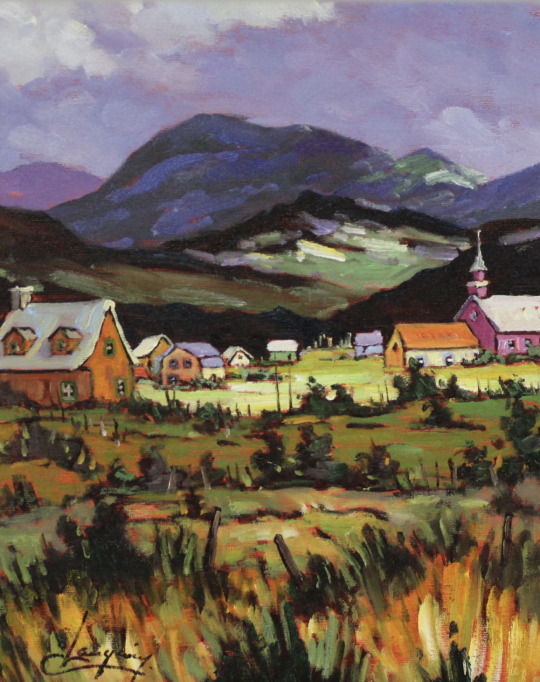
Claude Langevin (1942-2024): A quick painter of landscapes, self-taught! His use of the brush is reminiscent of the Impressionists. He wished to express his affection for his people and his land. His depiction of the Laurentian landscape allows the viewer to feel a strong unfailing connection between the artist and the region he calls home. His use of light in his works reminds me so much of how the sun illuminates the Saguenay region, much to my fond memories. Favorite painting: Au but de champs.
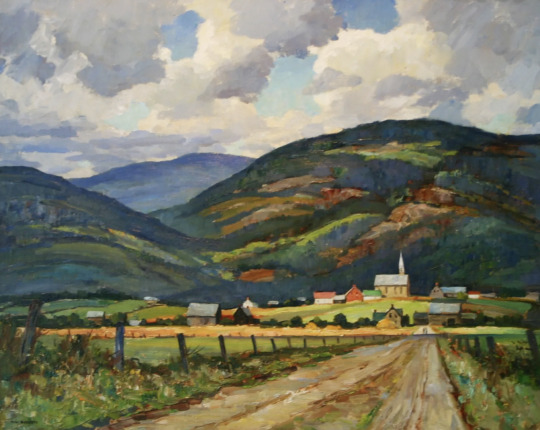
Tom Roberts (1909-1998): Born in Toronto Ontario. He drew inspiration from the Group of Seven and French Impressionism. His paintings, characterized by vivid colours and dynamic compositions, captured the diverse landscapes of Canada, from Northern Ontario to the Maritime provinces. His use of both watercolours and oils brings versatility and an array of variety! Favorite Painting: Quebec Landscape, 1950. Oil on masonite 24 x 30” in.
Books and Witchy Tools and Where to Get Them
Most mainstream anglophone shops like Chapters Indigo don’t have much. There are other options within Québec and in local regions for our books, and some of them ship elsewhere!
Archambault: this retailer has a lot of Quebec authors, music. Many books in their collections have folklore, regional histories, folk tales and more! Simply type the region you want, for example, Charlevoix or Saguenay, with any key words like “contes” and “folklore” and you’re bound to find a few good reads. https://www.archambault.ca
Septentrion: a bookstore specializing in historical monographs and scholarly works, especially those of France, Québec and any other region where we settled. https://www.septentrion.qc.ca
Bookmark Halifax: https://halifax.bookmarkreads.ca/. A local independent bookshop in our maritime province specializing in local interest authors and titles. Many features books include local history, graveyards, notable people, local plants, and so much more!
Carrefour Atlantic Emporium and Puffin Gallery: https://www.carrefouratlanticemporium.com. An eclectic paradise of local handicrafts, books, art from all over the maritimes! There’s a location on 1869 Upper Water Street, Halifax. I go there for most of my witchy tools like hand-carved spoons, woven tapestries, jewelry, statuettes, and lots of books on Acadian and Scots plants, folklore, history and culture books, as well and Indigenous titles. Sadly I don't think they ship, but always worth asking!
Honorable mention to Jennifer's of Nova Scotia! They're a local shop in Downtown Halifax where a multitude of local craftspeople and artisans sell their works! I get my pottery, tea, candles, art, jewelry, and trinkets from them! They only deliver within 20km of the store.
For those who garden or who are interested in Quebec-grown plants and seeds to incorporate into your spiritual path, here's a website to have a list of all available growers and seed providers! https://notreheritage.ca/semences/semenciers/#:~:text=Situé%20sur%20la%20Rive%2DSud,plein%20potentiel%20de%20chaque%20cultivar.
There's also the Pépinière Ancestrale, based in Saint-Julien, QC. a regional nursery for fruit trees, shrubs and plants! They ship to Quebec, Ontario and the Maritimes! https://www.pepiniereancestrale.com
That's all I can think of for now! There's certainly more, but here is plenty to get any of you started! Feel free to reach out and ask any questions!
#supportlocal#folk witch#acadie#quebec#french canadian#witchblr#christianity#folk magick#folk magic#scholarly
10 notes
·
View notes
Text
Trust Fall (Revali X Reader) - Part 1
Word Count: 2,780
Pairing: Revali X Reader (Female)
Fandom/Universe: Legend of Zelda (Breath of The Wild)
Themes/Content: Romance (Slow Burn), Fantasy, Action.
Warnings: None
Synopsis: You visit your friend in Rito Village in order to escape the sense of dread looming over your home of Castle Town as the prophesied doomsday slowly grows closer. It is here on your visit that you meet a Rito warrior who turns your world upside-down.
Authors Note: Finally got round to writing this! Since he's not mentioned in TOTK at all I just had to start a fanfic for him. I miss him so much. I'm uploading this from my laptop so if the formate is weird or there needs to be more paragraphs just let me know! I don't consider myself a pro on Zelda lore so I do apologise for any mistakes. Also, this fan fiction will have two endings! (One canon to BOTW and one canon to Hyrule Warriors) Other than that, I hope you enjoy! - I don't know what to call myself... should I go by my username? What about something stupid like Loafus?... I don't know... I'll work on it 🪶🤎
Rito Village was your second home. You felt so much comfort and associated the place with such a feeling of warmth, it was surprising you hadn't made it your permanent residence. When it came to Rito Village you only had positive memories.
This was mostly due to your best friend, Frita, being a rito. The two of you had met at a very young age and had been best friends ever since, visiting each other every couple of weeks or whenever you had spare time. She would teach you about the ways of the rito and you in turn would teach her about hylians. Frita truly was like a sister to you, and you loved her more than words could say.
"Daydreaming again?", her voice broke you from your thoughts, her bright blue eyes sparkling with joy. You blinked a few times, finally registering her words, and you couldn't help but giggle to yourself. "Yes, I guess I was". "What we're you daydreaming about?", she asked, turning her attention back to the salmon sizzling in the village's communal cooking pot, the aroma swirling through the air, making your mouth water in anticipation. Later in the night was the perfect time for cooking here as most ritos had gone to sleep; Their poor night vision meant that many would retire early in the evening. "Just thinking about flying", you confess sheepishly and Frita rolled her eyes playfully, responding with, "You're always thinking about flying". "I can't help it whenever I'm here. You all look so majestic and free", you gushed. "I would love to be able to experience what it's like to fly for myself instead of having to be on your back". "Perhaps if you pray to Hylia enough she'll allow you to become one of us", she chuckled and you couldn't help but laugh along with her. Frita eventually added the tebantha wheat to the pot and the goat butter as the two of you talked about everything under the stars. "Are you still planning on moving to Hateno Village?", she asked as she began to plate up your dinners. "Yes, unfortunately. It means I'll be further away from you", you mumbled and Frita's face fell in disappointment. "It's the best option as, if this impending doom really is to show itself one day, the city centre is most likely one of the first places to be attacked. If I could, I'd love to live here with you". "Well, why don't you?". You shook your head. "You know I'd stick out like a sore thumb here. I wouldn't be able to pull my weight or help the village in any way. I'd be more of a burden than anything". "Perhaps not! If I could find a way for you to easily integrate into life here, would you move here?". The more Frita spoke, the more you felt a warmth spread through your entire being. "You'd have me, you'd be well protected- our warriors are exceptional, there's plenty of food and resources in the area… just don't make any final decisions to move just yet. Allow me a chance". You chuckled, taken aback by your friends willingness to help you and keep you by her side. "Okay, I'll give you a chance".
You cut yourself short when you noticed movement out of your peripheral vision. The gentle padding of talloned footsteps grew closer and bright emerald green eyes encased in bright red watched from the darkness. Finally a rito came into view. "Rather late to be cooking, don't you think?". His tone was sharp and precise, you couldn't tell if he was making small talk or if he was irritated with the fact that the two of you were occupying the cook pot. Did he usually use it at this time? "Oh! Revali! Sorry, did you want to use the cooking pot", Frita asked, a light quality to her voice as she politely addressed him, yet an awkward silence seemed to settle over the three of you as his eyes travelled from her to settle on you, staring down his beak right into your very soul. "Who is this hylian?", he asked bluntly. "This is my best friend. She's visiting for a short while", she informed him of your name and that you were from Castle Town. "Would you care to join us?", you then offered, cutting through the awkward pause in conversation. "We have plenty to go around". Frita cut you a glance, surprised by your sudden offer, but did not protest, adding "Yes, do join us! I'm assuming you've just finished practice? You must be famished". Revali opened his beak but quickly shut it, perhaps to reject the offer but thought better of it. He took a moment to smooth out the cream scarf around his neck. "Well, if you insist, I suppose I could join you", he hummed, making his way to sit across from you.
As he took his seat, he placed a beautifully crafted bow to his side, coated in vibrant colours and intricate designs, a scrap of teal fabric tied to one end. He held himself with pride, sitting tall, spine straight, shoulders squared. With the fact that he was taller than you, it was a little intimidating. "Have you visited our village before?", he asked, and it took you a second to realise his question was directed towards you. "Oh yes, plenty of times. I've been visiting since I was a child. That's how I met Frita", you explained, gesturing to your friend as dinner was being dished onto plates chiselled from stone. "Hmm, surely I would have met you by now if that were the case", he muttered as he was handed his food, "it's interesting how our paths have never crossed". You shrugged unsure of what else to say, other than, "Perhaps we weren't meant to meet yet. Us meeting now may be fate?", you laughed lightly, amused by the thought. Revali scoffed in response, "I believe we are in control of our own fate. For example; I didn't become one of the greatest rito warriors through fate and sheer dumb luck alone". "And so modest about it too", you joked which caused Frita to just about choke on her food. She tried to excuse herself as calmly as possible, covering her beak with her wing while still coughing her lungs up. Judging by her reaction, you considered how you may have overstepped a boundary. Not everyone knew when you were joking upon first meeting you. You often sounded more serious than you intended. "I'm only teasing", you clarified, playing with your food on the end of your fork absentmindedly. "I'm sure you're more than deserving of the title", you tried for your most sincere smile you could conjure, yet Revali didn't seem convince.
Finally, Frita had caught her breath, tears in the corners of her eyes. "No no, Revali really is the greatest of our warriors. Our people gave him that title", she croaked, her throat sounding raw from coughing. "He's the pride of the rito", she insisted, dropping her voice to a more serious tone. Your face contorted in amused disbelief before you began to wrack your brain for any information that would help you deduct the truth. "So he is the rito that's won the annual archery competition for the past five years? He's that same-…", you began to trail off, recalling the conversation you had with your father.
You came from a wealthy family, both your parents working for the King and late Queen of Hyrule . Your mother was the royal gerudo correspondent and your father was the royal rito correspondent- this being the reason you spent so much time in Rito Village growing up, as well as Gerudo Town. You remembered the past few years you couldn't make the annual archery competition held in the village, since you were either accompanying your mother on business trips or doing your own work, but you father had come home stating how the rito 'Revali' had won again. He would then follow up by talking about his superb skills and how his talent for aerial combat were superior in comparison to his peers. Your father claimed that the rito was unmatched and unrivalled, as well as claiming that he may very soon be known as one of- if not the most skilled warrior in all of Hyrule. (Which was very high praise coming from your father, since he was rarely impressed by anyone).
It was like a shock wave was sent through your body. "In the name of Hylia! I didn't realise it was you! I am so sorry! Please forgive my rudeness", you blubbered, putting your half eaten dinner aside, stumbling over your words as you rushed out your apology. "So you have heard of me", he lulled before an amused smirk graced his features. "I suppose I can forgive you since your rudeness was more disbelief than pure ignorance". "Thank you”, you breathed a sigh of relief. “I have heard a lot about your skills and I-… well…", once again you had trailed off. You looked to Frita for reassurance, yet she seemed as nervous as you; her posture was stiff as she sat with a straight spine, her eyes glancing between you and the navy rito. "From what I've heard, you're an incredibly skilled archer", you approached the conversation cautiously, hoping this angle would amend any bitterness you may have caused. Revali looked a you and you felt your breath catch in your throat as you locked eyes before he let out a gruff chuckle. "I suppose you could say that".
You and Frita ate in a comfortable silence while listening to Revali drawl on about the countless competitions he's won along with his many talents regarding aerial combat. Before long, your mind began to wonder.
You couldn't help but think of home. How it was slowly being consumed by a festering anxiety. There was a heavy air across the whole of Castle Town as you all prepared for this prophesied impending doom. The army had began vigorously training since last month. Some of those warriors were your friends- people you had grown up with. It was terrifying to think how some of them you may never see again once the Calamity strikes. Some were beginning to research the ancient technology that had recently been unearthed to see if they could be used to defend Hyrule. These were called guardians, and then there were also the recently uncovered Divine Beasts. At times, it was all a bit much, being at the central hub of Hyrule where there is no escape from the looming sense of dread. Things were moving so quickly and it seemed as though you may never escape the ever present anxiety that hung in the air of Castle Town. But here, in Rito Village, people seemed more relaxed. Many ritos believed that their home would not be effected by the foreseen Calamity. This made the village a nice escape from daily life back home. Here, you weren't reminded of what was to come. You weren't reminded of your duties. You could just breathe easier here in the village nestled into the rocky pillar.
"I do love it here. Rito Village is such a beautiful place. I don't have a single bad memory while being here", you gushed, earning a raised brow from Revali at your comments about his home, his interest now piqued. "Is that so?". Before you could stop her, Frita spewed, "Yes, in fact, she might move here". You shot her a look, a signal to keep that information between the two of you, to which she sheepishly dipped her head in response. You didn't want others knowing of your plans to move just yet, especially since you hadn't even mentioned it to your parents. "A hylian living amongst ritos?", Revali questioned, an amused undertone laced within his words as his luminous eyes narrowed a fraction, as if trying to read your expressions for some sign of the truth. "Hylians aren't equipped for living here. You would struggle". "Yet so many visit and get by just fine", you bit back, sharp tongued yet it was all said with a simple smile across your lips. What he said was true, yet you disliked how he assumed you would struggle when Frita, a fellow rito, believed you could easily adapt to life in the village. "Visiting and residing are very different though", he then shot back, cocking his head to the side as he examined you and your heart began to pound slightly. You felt a pout develop on your features, brows furrowed. He made a point you couldn't argue against. It was the truth. "Well, I'm taking it upon myself to help her integrate into the village before she permanently moves here", Frita chipped in, sensing some tension settling in the air. "If you truly want to move here", Revali began, capturing your attention once more. He wore a smug smirk before he finished, "You'll have to prove yourself".
"Prove myself?", you parroted. "Yes. You'll have to learn our ways and prove to us that you belong here". Revali studied you for a moment, as if he hadn't been doing so all night already. "Firstly, the women of our village are know for being beautiful singers and us men are talented archers. Tell me, can you sing?".
Being from one of the wealthier families of Hyrule Kingdom, you did have the privilege of music lessons from a young age. Your parents wanted the best for you, so consequentially, you had many lessons in a multitude of subjects and areas; Geography, horse riding, music, dance, literature, cooking, etiquette, biology and more.
"I have had many singing lessons", you informed the feathered man matter-of-factly. "It's more a matter of personal taste weather you believe I sound good". "Perhaps you could sing for me tomorrow then. After my training, well meet at the flight range. You can showcase your voice there", he challenged, the smirk across his features growing as he stared down his beak at you. "After all, it would be rather nice to have something to help me relax after such strenuous training", he teased. "And if my voice is to your liking, what do I receive then?". There was a slight pause. "What do you mean?", he tilted his head slightly, perplexed by your response. "Well, if my voice is to your liking then that would mean I have somewhat proven myself worthy of living here amongst your kind", you began, Revali's attention honed in on you, "Which I believe would be worth a reward". "Your reward would be living amongst us", you ignored his comment, pressing on. "That being said, if I prove myself, then I would like to learn archery". "What good would that do you?", he asked. "It's always good for a woman to be able to defend herself, wouldn't you agree?". "But if you were living in Rito Village you wouldn't need to defend yourself", he argued. "I'd have to say it's always good for a woman to know how to use a bow", Frita affirmed your point, edging a little closer to you as she joined the conversation. "Especially a hylian. They are smaller than most races, so it's most likely that any threat they face will be larger than them and could over power them", Frita continued, delving more into her argument. "Exactly, Frita! Meaning wouldn't it be beneficial to have a long range weapon in that instance? Surely, with your knowledge on combat as one of the greatest warriors of our time, you'd agree, Revali". You couldn't help but notice how the feathers around his chest plate plumed in reaction to your words. You'd noticed many ritos would unintentionally do this when feeling prideful, being boastful or being frustrated or angry. Perhaps it was a subconscious way of asserting dominance? Like how a Hylian may square their shoulders to appear larger and more confident in front of others. "It would be an honour to have you teach me".
There was a pause.
"I suppose it would be beneficial for you to have the most skilled archer teach you…", he mused looking off into the night, as if he barely acknowledged your being , like you were nothing more than a speck on his radar. A nuisance. "Alright, you have yourself a deal; continuously show your willingness and progression to integrate into our society, and in turn I will teach you how to use a bow". "And you swear not to go back on your word?", you quirked a brow in Revali's direction. "I swear".
#breath of the wild#legend of zelda#tears of the kingdom#botw revali#revali#x reader#revali x reader#botw tears of the kingdom#totk teba#rito village#rito#loz rito#prince sidon#tears of the kingdom sidon#loz botw
327 notes
·
View notes
Photo

Diversity in Church Architecture in Medieval England
Medieval English churches differed in size and layout. Their original and evolving role(s), financial and material resources, and architectural fashions helped determine variability. However, their look ultimately grew from a constant symbiosis between being a place for worship and practical matters. During the 10th-15th centuries, stone construction became firmly established, and that witnessed a golden era of church building.
Purpose & Resources
Immediate, mundane reasons for diversity were just as for any other buildings – houses, castles, offices – it depended on the purpose for which they were originally built and the financial and material resources available to the initial builders and to later owners who wanted to extend and/or beautify it.
Impoverished communities created basic churches employing the means and materials members of the settlement possessed or could source nearby using their own sweat and skills. Rich sponsors had the wherewithal to envisage and execute the most lavish projects money and authority could buy, transporting materials from far and wide, engaging the leading designers, technology, masons, metalworkers, carpenters, painters, and glaziers of the day.
Basic buildings might be erected as outposts of mother churches/minsters or by individual villages or minor landowners wanting a place, however humble, to express their faith, as a centre for the daily, weekly, and yearly cycles of devotion that dominated and led peoples' lives. They were simple rectangular structures, large enough for maybe 15 to 20 worshippers. The grandest undertakings were sponsored by major royal, aristocratic, or religious order benefactors to produce leading centres of ecclesiastical, administrative, and scholarly influence. Many of the great cathedrals, abbeys, and minsters, like Durham, Lincoln, and Old St Paul's London were wonders of the world at the time they were built, well over 100 meters long, 100 meters high, or more, and tens of meters wide.
Of course, the majority of churches fell in between these extremes. Some might not initially have been conceived on a grand scale, yet over the centuries they grew as patrons and communities responded to changing population sizes and advances in building technology that fed the desire to always have the bigger, better, more beautiful, the latest architectural fashion. In the economic climate of the later Middle Ages, fresh sponsors of church building and extension entered the scene. Newly rich guilds and merchants in many towns employed their wealth to craft ornate chapels or enhance an existing church with which they were associated. From unpretentious origins, many modest buildings thus grew into impressive houses of God – witness Leicestershire's grandest church in Melton Mowbray backed by wool traders' money, and the great wool churches of Norfolk and Suffolk.
Continue reading...
30 notes
·
View notes
Note
What are your thoughts on some of the unused concepts within Village? I thought the idea of a sort of shamanistic figure alongside the “five” houses with Karl’s father as the mayor would have been interesting but given the small scale of Village, so perhaps something to that extent if they village was larger — not to mention Moreau’s unused section. At any rate, yeah — I honestly really enjoy reading your analysis of the lore so I’m curious as to what you think of the game’s unused concepts.
Well, this one's tricky to answer, because it seems like whatever you're really asking got lost in a long run-on second sentence there. But I'll do my best.
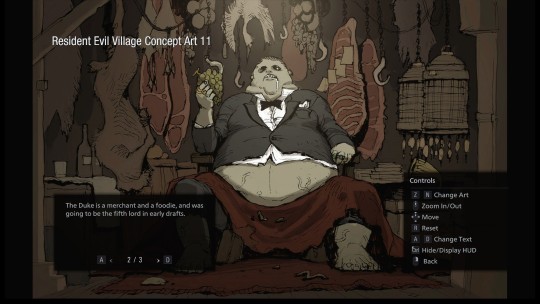
I think we should start by pointing out there's no reason to think there was ever "a sort of shamanistic figure alongside the “five” houses with Karl’s father as the mayor." Project development is like any other kind of history: it doesn't all happen at once.
The Shaman appears only in the trial storyboard, and that features only four lords. The only hint that there was ever a 5th lord is a half-sentence attached to one piece of concept art of the Duke that says he "was going to be the fifth lord in early drafts." Does that mean there was a fifth lord present at some version of the trial, that he was even going have his own village area? Or was the Duke always meant to play the role we know, but with a reveal he was actually a long-deposed lord to Ethan near the end of the game? Heck, was there a version where the Duke leads the trial in place of the Shaman? I have NO IDEA, and nor do you.
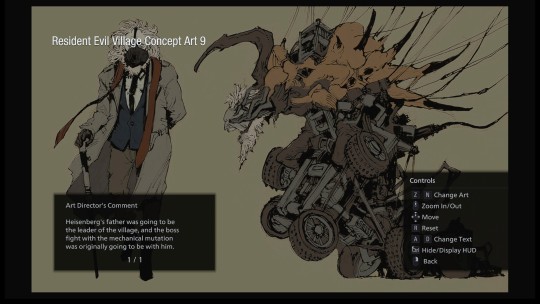
There are concepts which mention Heisenberg's father as the village's mayor, yes, but there are also concepts which describe Urias as the village's former 'leader' (does that mean mayor?)
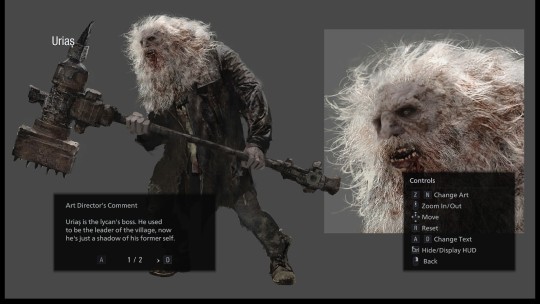
There are still other concepts for 'the leader of the village's religion', who isn't Miranda and doesn't look much like the Shaman from the storyboard either.
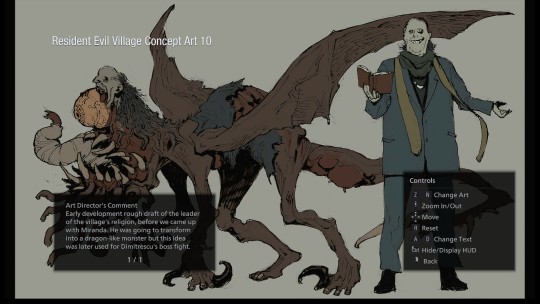
There was another point where Sturm was apparently going to be Heisenberg's father.
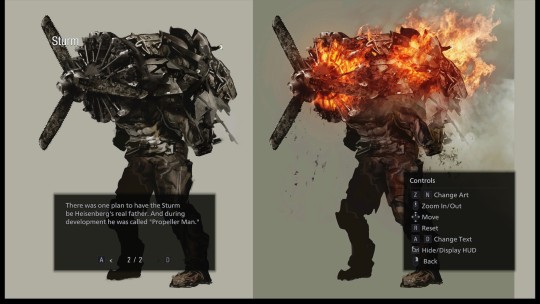
Lots of different ideas along those lines were obviously thrown around at different stages of development, and lots of characters clearly had conceptual backstories that there was no need or no space for in the finished game. Some we know were cut because there wasn't the time or resources to realise them (such as the idea of building an entire fishing village for Moreau's area, or for putting 100 witches in Dimitrescu's castle). But others would have been reworked because unrelated changes make them superfluous.
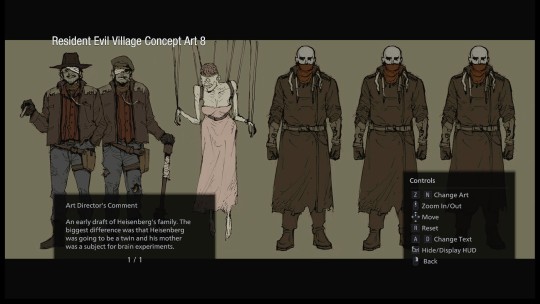
Take the four lords, and their families. Heisenberg at some point apparently also had a father, a mother, and at least one twin brother. Heisenberg refers to his household in plural in the storyboard, and even Moreau alludes to a family of his own. There are concepts of a large Beneviento family with multiple children too.
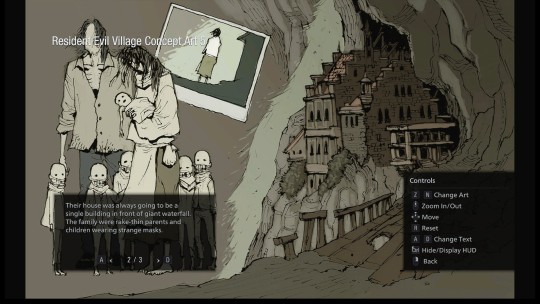
That's all the more interesting because family (particularly families that are twisted and dysfunctional) is one of the strongest running themes in RE7 and 8 (and I'll be very interested to see if it continues on in RE9!) Back when it was a Shaman leading the trial, there's little suggestion that the four lords represented any unified family ‒ but perhaps the family theme would still have been present with their individual families, in their individual domains?
Once Miranda and her quest to resurrect her daughter have been reworked into the centre of the cult, however, her fixation on motherhood comes to the fore, and the cult itself is now a one big, dysfunctional family: at that point, giving all the lords their own families was probably redundant (and not having to create that many extra characters and potential boss fights was probably a bonus too). I'm curious as to what the Heisenberg family dynamic might have been like, but I'm also fascinated that he's still so recognisably himself in that early storyboard, even though Mother Miranda doesn't exist yet.
Personally, unused concepts are of most interest to me not as cases for 'imagine if this was in the game' but for what they can illuminate about elements that were mostly-but-not-completely-cut from the finished product ‒ see, for example, the case of Moreau's movie poster. The idea of the Duke as a 5th lord is intriguing mostly because it suggests there was a time where we were going to get some real explanation as to the Duke's implied powers and relationship to the village ‒ perhaps even some story as to how he became estranged from his position. In the finished game, he's left very deliberately mysterious.
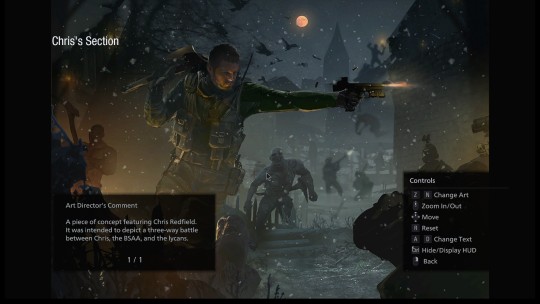
I'm very curious about the phase where there was apparently a plan for a huge, three-way battle between Chris' team, the lycans and the BSAA in the village ‒ not because I think the game would be better for having it, but because what's left of the BSAA element in the finished game feels like an awkward footnote that just doesn't fit.
I'm fascinated by those unused red eye textures for Rose that survived all the way to the released game ‒ and only more so after someone pointed out to me you can even see a shot of Rose with red eyes in a storyboard for the start of the final battle with Miranda, which appears just briefly in the background of a making-of video. The same commenter also suggested that Rose was draining Miranda's powers in that shot, which seems like a bit of a stretch to me, but would explain why Miranda's power suddenly leaves her for unexplained reasons in the finished game. Unused concepts have so much potential to answer questions the finished product left dangling!
The knowledge that Miranda was originally just supposed to be a foreign research sure casts those photos of her from the lab in a very different light, and even makes me wonder if they were created much earlier in development than I would have assumed. And heck, there are so many fragments of an extended and surprisingly coherent pre-game timeline still lying around the early chapters of the game that I'm very curious as to whether there were originally far more scenes planned before the main action began.
Cut content featuring Elena has me incredibly curious too ‒ mostly because bits of it made it all the way to the early trailers, and there's a quote from the actress herself talking about how the character originally died in different circumstances. Those aren't just early concepts, they're aspects that came really close to making it into the finished game.
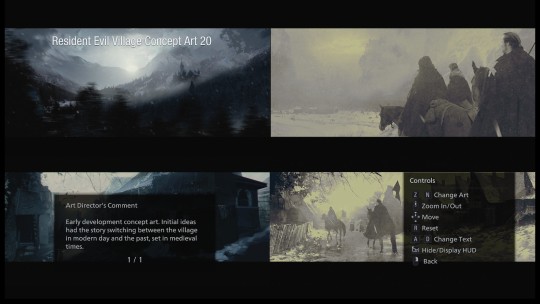
If you really want tantalising unused concepts though, one of the most intriguing is this one screenshot where they talk about early plans to have the story jump back and forth in time, with a major chapter set in medieval times. That would be like nothing RE's ever done before, but it certainly hints at the intent to create an even longer and more detailed history for the village. Would we have had a whole separate protagonist in the history segments, ala Clancy from RE7 from the videos, maybe?
Speaking personally, the one thing I felt was really lacking in the lore was the whole cadou concept. Nothing in RE8 feels more like a weak attempt to copy RE4 than the fact the mould is also parasite now, for some reason. Nominally, the cadou is part of how Miranda converts and controls her creations, but Eveline does all that with mould alone, and even in RE8, we see someone transform into a lycan after merely being bitten. Documents talk about cadou-implantation, but the ending sequence shows villagers becoming lycans after a mere injection (and we know this doesn't predate Miranda's creation of the cadou, because there's one floating in a jar).
So what is the process? What does the cadou add to the mythos that simply injecting people with mould wouldn't? RE4's lore is an incoherent mess that falls apart under the least scrutiny, but it at least commits to the parasites as central to its cult and monsters. C'mon, RE8, if you must stuff the parasites in somewhere, work them into your theming! Don't give me some weaksauce bull about them being 'based on nemotodes' in the Japanese text, at least tell me Miranda births them like Marguerite does her bugs, and really lean into all that twisted-mother imagery! They already look like mutant fetuses, the next step is right there!
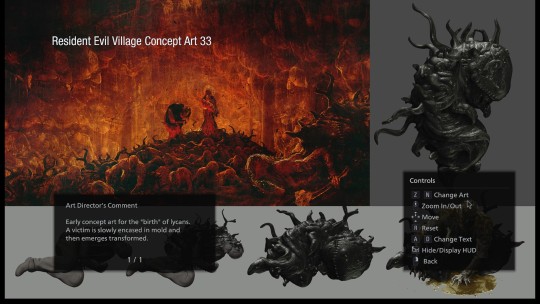
So it's very interesting to me that there's art of an earlier concept for the creation of the lycans, where victims were encased in mould to form a very cadou-looking cocoon, from which a lycan would eventually emerge. That strikes me as a potentially way more interesting concept than the vague nematode-parasite stuff we got. Alternately, the idea from another piece of concept art of villagers becoming lycans after they 'drank from a chalice' puts a whole different spin on the giant's chalice as a plot point.
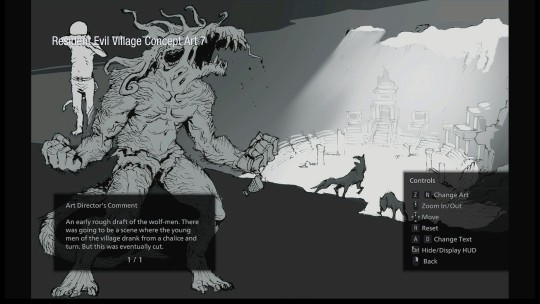
Fascinating as some of these concepts are though, I do feel that most of what didn't make it into the finished game was cut for good reason. Pacing and streamlining matter, and plenty of mysteries don't need to be explained. RE8 would not have been a better experience padded with every unused idea to the length of the new RE4 (and I'm not fully convinced even the new RE4 needed to be that long). I would happily pay real money for a proper RE8 artbook with yet more juicy details on how the game came together, but most of what wound up on the metaphorical cutting room floor probably wound up there for good reason.
38 notes
·
View notes
Note
gimme a random lil lorebit!!!:00 i love loree
(And lore you shall receive! I am incredibly keen to share it!
So, let's roll back to 1000 years ago. Arkaedia was pretty prosperous. Everyone lived together in peace and harmony. The great type alliance was going strong. Technological breakthroughs were happening left, right and centre. There was no division among Pokémon types though there were leaders who helped to maintain relations between different Pokémon. These leaders were in a group called the leaders of Arkaedia. This group has been going strong for well over 400 years, since their ancestors from back then decided to migrate to this land from the wasteland that is considered the outlands.
The Pokémon in this group were Drazee (drapion), Mystola (Hatterene), Kinetic (Magnezone), Rehana (Infernape), Symbia (Golisopod), Agnes (Golem), Maximus (Dragonite), Reginald (Abomasnow), Oasia (Persian) and Spect (Cursola). They were all pretty friendly with each other. Reginald was the oldest of the bunch and Kinetic was the youngest. Their jobs were to ensure food, resources and other goods were distributed equally and fairly amongst the many villages that littered the land. The three that were the closest to each other were Drazee, Mystola and Spect. They were almost seen as the core three leaders, making a lot of decisions with their roughly 20 or so years of experience on the Leaders of Arkaedia council. It was pretty good going for all of them. Everyone enjoyed everyone's company. Rumours had it that relationships also formed amongst the members of the group.
Too bad this all changed. A shame really. A decision which caused a key moment in history for the Pokémon of Arkaedia.)
7 notes
·
View notes
Text
PERISCOPE

FanFic translated from Spanish to English.
Chapter 2
In the mountains lay the province of Drum. The Drum Rokies, a nature reserve and the lungs of the country, covered more than two-thirds of its territory. Its highest peak, where the historic Drum Castle stood, rose five thousand metres into the sky. The range formed a circle around the only three small villages in the province: Bighorn, Robelle and Gyasta, which in turn formed a semicircle around a lake in the hollow at the centre of the range. Access to the villages was easy in summer, via a winding road that cut through the mountains from the neighbouring province of Arabasta, down to the lake and the village entrances. But winter was different. Snowfalls came and went, with hardly a break in between, and the snow reached heights of more than ten centimetres. The passes were closed and the three villages were cut off for weeks, even months, as the road was completely blocked. The previous year had not been a particularly harsh winter, yet the province was cut off for 28 days. Army helicopters dropped crates of supplies and other necessities to keep the inhabitants of the three towns from running out of resources. But the people knew their territory well and, as in the tail of The Cicada and The Ant, they spent most of the year stockpiling household goods, medicines and canned food in anticipation of winter isolation. This year, however, according to the weather forecasts, was going to be even harsher. The snow had started at the end of October and had fallen intermittently until a Friday three days after Christmas. The snow was more than a metre deep. Cars had to be driven with chains and people were covered up to their eyebrows to keep warm. The barometer was five degrees below zero. A low-pressure front from the North Sea brought a cold snap to Drum that would not leave the province until mid-February. Local TV and radio stations announced snow, high winds and thunderstorms, and that the road to the neighbouring province of Arabasta would be closed that night. Drum would be cut off, as it is every winter. And Roronoa Zoro didn't give a damn about it.

21 notes
·
View notes
Note
i wish to know more about the culture in Pheonix Drop, the central place for a lot of stuff in mcd :3
Ofc!!
Cut bc it’s a long post:
When it comes to Phoenix Drop, there’s not a lot of very evident ‘aesthetic’ culture. In the sense that clothes are often bland or bought from other villages and towns, as the people of Phoenix Drop cannot afford the time to spend to making clothes. Buildings are basic and run-down, patched together with any available techniques and materials as opposed to committing to a style. Hair is often thrown up into a hairdo and covered with a kind of veil instead of being intricately woven as there’s just not enough hours in the day to commit to it.
Clothes can vary. A lot. Most of PD’s inhabitants are not PD natives, they come from other places and brought with them shreds of their own culture. Some people can be seen wearing bright fabrics and patterns, but it is especially rare, as most will sell their nice clothes to any merchants or travellers who happen upon the village in order to have the money to eat - no one who lives in Phoenix Drop tends towards the wealthy side, excluding one individual in particular.
As there is not a large amount of food or resources, most jobs are centred on getting the bare minimum of everything they need, instead of getting the best, as they simply cannot afford it. Most clothes made in Phoenix Drop are plain, often varying shades of Beige (sometimes dyed or stained, if the buyer has the money to spare, most don’t) and shapeless. It’s focused more on keeping people cool and covered, as Phoenix Drop is set in the warm north-east. At most, people tend to accessorise with leather straps and wooden beads. They just don’t have the excess time or money to waste metal on jewellery instead of weapons.
Those with a little bit extra might be able to travel out of the village momentarily, or to afford the prices of clothing merchants who arrive in the village, and will buy some clothes of higher quality. This can include corsets/stays/support pieces, which are often low quality at the prices they can afford and not particularly pretty, or clothes that are slightly brighter in colour.
All clothes will eventually tear and wear holes, and get patches and stains, so having a clothing item which looks entirely new is pretty sought after. They will sometimes trim the edges of their skirts/trousers/sleeves in order to get rid of torn/fraying/stained edges, which can eventually shorten them quite considerably. Eventually, having long clothes also became a bit of a status thing. Even though that meant they were then more easily stained, and torn… which meant they’d have to be cut… and it’s a cycle.
Hair covering is a bit of an older tradition and isn’t followed by everyone, but it’s one of the aspects of PD’s culture that is a remnant of its former actual culture. The veils are usually quite small, and don’t cover all of the hair, but it does depend on the individual, and the material can really be anything, the weight in the tradition lies in the symbolism of wearing it, less in the covering of the hair, so things like lace and more sheer fabrics are acceptable. Of course, no one in PD is rocking a lace veil, no one is that fancy.
Even those that don’t cover their hair tend to style their hair in a particularly dull way. There is nothing unique, it is usually just a bun or other kind of knotted hair. It is based off of former PD cultural hair styles that no one had the time to do anymore, after the village grew far too poor to focus on anything but work, and just kind of got lost.
Having your hair tied up is definitely expected if your hair is long enough to tie up, even for men (this rule also goes for facial hair). Those who don’t are often people who are seen to… lack any kind of dignity, and this isn’t always seen as a negative. It’s a good way for prostitutes to be able to subtly market themselves during the day, whilst also being able to be covered from the sun. And anyone can have their hair down, it’s just something that can lead to confusion if someone is new in town and doesn’t know that you aren’t offering those services.
For music, it’s not easy to get your hands on, and then maintain, instruments. A lot of music is made through vocal means, or instruments that are more durable and/or easier to fix/make. Drums, for example. People cannot dedicate their entire lives to figuring out how to make music sound good in PD, so it tends to just be a little bit unskilled, but that’s the charm of it. Usually music comes in the form of drunken chanting and banging their fists on tables/stomping, so it takes on a very rhythmic beat. Totally not because it sounds like a heart beat and I’m shoving heart symbolism everywhere… totally…
Anyways, it’s very common for people to hum and sing as they work. As they’re working all day, it helps break up the monotony. They have some songs about the tales of Irene and such, but most are just bullshit they’ve come up with when drunk or delirious. Brendan is responsible for half of them, if because he’s been half-asleep mumbling to himself, or he’s accidentally hit someone over the head whilst he was working.
There’s a lot of jumbled language. Like Phoenix Drop has people from a bunch of backgrounds, and so after a while they’ve just kind of mushed together words and phrases from different places for things. Kind of like how, irl, we get things like Spanglish when someone mixes Spanish and English words and phrases.
They have some very bizarre phrases and sayings because they originate in other languages but they just started saying it in common and it became A Thing.
And there’s more but this post is LONG.
I could go into the work culture, social norms, all that. I’m insane.
14 notes
·
View notes
Text
‘We cannot be cowards’: the Brazilian village fighting for the right to have water
Latin America’s water wars: In a struggle that has already cost one life, a community founded by those who fled slavery is fighting to save its access to water and way of life against encroaching farmers
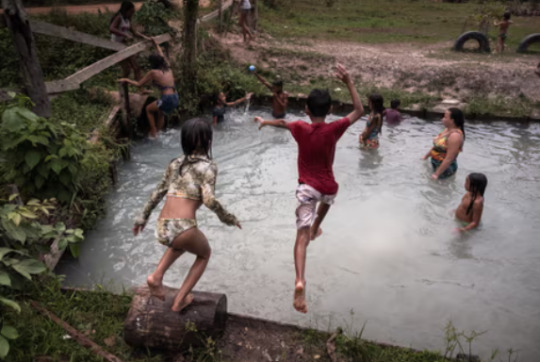
Beneath the family television stands a collection of trophies and a photo showing a smiling Haroldo Betcel sporting a football jersey. Smiling back at him is his widow, 41-year-old Cleia Betcel. The photo was taken a month before her husband’s murder.
Five years ago Betcel was stabbed in the back with a screwdriver in retaliation for defending water resources in Tiningu, a village on the edge of the Amazon rainforest in the Brazilian state of Pará.
Tiningu, whose pastel-coloured houses are home to 300 inhabitants, was originally a quilombo, a settlement founded by black fugitives from slavery. For two decades, this region’s fertile land has been settled by numerous farmers, known as fazendeiros, who grow cereal crops.
The five natural water sources – rivers, streams and creeks – that supply Tiningu increasingly attract farmers seeking larger parcels of land, leading to a fierce struggle over water. Betcel’s widow recalls when tensions began to appear in the village. “When a fazendeiro who settled in Tiningu decided that the water source we used belonged to him, my husband reacted – because water belongs to everyone,” she says.
The fazendeiro – a fish farmer named Silvio Tadeu – claimed ownership of a water-access point previously used by the community, including the health centre, that he said was on his six-hectare (15-acre) property. Villagers say that the farmer also banned children from swimming and bathing in the streams he now considered his own.
This posed a problem for the residents, who had long used water communally. Ademil Martínez Riveira, Haroldo Betcel’s uncle and president of the Tiningu Association between 2014 and 2018, says the community raised funds to build a 6-metre-deep microsystem to supply groundwater to the public water point.
Continue reading.
#brazil#brazilian politics#politics#antiracism#environmental justice#quilombos#mod nise da silveira#image description in alt
23 notes
·
View notes
Note
We have a housing problem what problems do you forsee and what solutions would you suggest for the upcoming projects?
Hi Anon, Thanks for the question
One of the big problems we will face with getting the number of houses built that this government has targetted is the requirement for parking spaces for those houses. We can no longer build streets of terrace houses because each house is supposed to have room for 2 cars. This is why new build blocks of flats come with carparks and new build houses usually come with front parking spaces or garages.
I'd like to use tech to solve the problem there are underground parking garages that would fit in almost any community but they come with the risk that a breakdown would cause a neighbourhood to be without access to their cars. I've seen examples of this on Tom Scott's YouTube here which can include electric car charging and are much more secure than on-street parking.
Storing cars off the street like this makes them a hassle to access, which means that you need to build the area around that limitation. While discouraging driving you have to provide all the things a community might need. Every 100 or so houses should have a shop or commercial space, every 250 houses should have a park. This makes the area walkable and enjoyable for families.
Every 1000 houses should have some form of community resource which might be a community centre, doctor's office, library, school or faith building. The community resource should be the last thing that's built, there should be space earmarked for it and when residents have started to buy up the finished properties and move in they should get an opportunity to decide what they think they would use most.
These should often be built in conjunction with one another, if there's the opportunity for 5000 houses to be built near one another. We could end up with a village that has 2 primary schools, a doctor's office, a library/community centre, and a church for the community buildings, while in the commercial spaces there could be 5 corner shops, 5 charity shops, a salon, a barber shop, a bank, a local supermarket, 5 pubs or takeaways, 5 other faith buildings, a telecom exchange, 6 electric substations, a retirees centre, several spaces for small local businesses/offices, and to fulfil the green space requirements there'd be 10 small parks/playgrounds and 1 larger park with 10x the space maybe with basket ball/tennis courts, lawn bowls, some football posts on a field and a set of toilets. This would end up being a somewhat balanced community with room for many different sorts of people to move in and become a community through their shared access to these spaces.
Social housing should be an integral part of every community, 1/10 homes being one that should be sold to a social landlord or council, these should be picked at random so it's impossible to tell which streets or which properties in a given street are social landlords vs owned by the person living in them vs private rented. They absolutely should not be the cheapest houses the building company can provide that meets the social housing specification while other houses in the same area are bigger or have more things built into their fabric.
Making a village like this walkable and limiting the parking to the parking structures means you can forgo streets and use many of the road spaces as green spaces with walking paths, trees and so on.
If I were designing this I'd have concentric circular roads connected by spokes on T junctions where the 4th road goes into a parking structure and the spoke roads may be on every 3rd or 4th 'street'. the result should be no one is more than a few minutes walk from one parking structure or another, and each structure could have storage for 50 to 100 cars, which would probably mean people would end up meeting at the structures around rush hours adding more opportunities to build the community.
I understand that this wouldn't be workable in all areas but I think that if 5-10% of the projects looked like this they'd be able to provide a higher density of housing with an improved local environment over the concrete jungle with tarmac driveways and tiny gardens model which has come to dominate in many new build locations.
Even though I think this is a good solution, I understand that it could only be done with planning directed by the government because this shift in the layout and structure of new communities is rather radical. I see that it would face huge amounts of resistance from commercial ventures thinking that it's not viable, installing the technologies is going to take skills and extra money we don't currently have easily available relatively speaking, even if I believe there would ultimately be an appetite for this sort of community and people would easily adapt to living in these sorts of villages because it's so different it might take time to be accepted.
Yet another Complicated answer for a complicated world and this isn't the only solution out there. I'd like to hear from other people what they think of this idea and if they could see themselves living in a place like this.
#politics#adj4mp#anon asks#social housing#affordable housing#housing#infrastructure#walkable cities#complex answers#nuance#I'd like to see this but I don't think it will happen
5 notes
·
View notes
Text

ilya, a tiercel harpy (formerly a messenger)
a flock's population growth follows a clear pattern of succession - starting with the cobs and pens who form the foundling society at their chosen location. at a certain flock size or degree of danger, one of the flock members will become a king who takes on a defensive role. a flock is only as good as its king, and the king is supposed to represent the flock's strength and wealth. and this wealth is displayed by the king's collection of tiercels. any healthy, terminal [at its maximum development stage] flock has a king (or several if the flock is distributed over a large territory, with many small population centres) and a contingent of tiercels
the tiercels are nearly always willingly taken. they are chosen by kings to fit into a collection - kings' tastes vary but it's often easy to spot the theme; all greyscales, jewel tones, or reds. a tiercel is chosen if their beauty will enhance the cohort and also if the king wants to fuck them. what does a tiercel do? absolutely fucking nothing. they are non-reproductive, non-hunting, non-fighting members of a flock. their job is to look beautiful and to show off the prosperity of the flock; to have individuals who do nothing but drain resources is a very compelling display of power and wealth.
although a king will have a commanding role, it cannot be taken by force. in fact, kings are exiled from flocks at proportionally higher rates than any other type of harpy. if they don't act as a perfect symbol of power, the flock risks falling into disrepute, so the rank and file cobs and pens will just kick him out, and his tiercels will go off to find more worthy kings to take them in.
Ilya (pictured) was born in a human village and provided an invaluable service to the region by carrying post. when the king Cuinn chose them to be his first tiercel, it was not a popular decision. it was already very unusual for a flock in a human village to have a king at all - falconers had been known to carefully cultivate their flocks to avoid any kings being made. a king, they thought, was nothing but overly aggressive, domineering, possessive, pushy, and likely to injure humans if he disagreed with their treatment of 'his' flock. a harpy who looked like they were about to become a king was often either kicked out, or deprived of food for a number of weeks to prevent the change. Cuinn arrived as a wild king who had been exiled and left for dead, brought by a falconer who wanted to nurse him back to health and let him leave whenever he liked. he just never left. when he snatched away Ilya from the neighbouring village, soldiers were sent to rescue Ilya, who had absolutely no problem with not having to work anymore. Cuinn rebuffed any attempts to rescue Ilya.
The result, however, was unexpected. With the flock reaching a respectable status at last, the cost of keeping Cuinn and Ilya was offset by wild harpies who came to join of their own free will, and Ilya's old messenger position was easily filled again.
144 notes
·
View notes
Text
Day 5: Sand
328 Words.
Scar tells Grian about his dreams of a monopoly.
"Take it all in Grian."
Scar had a confidence that was… infectious. He had ridden the camel from the village loudly, with little of the fear that Grian had expected from first yellow life. He supposed that pledging his two remaining non-lethal lives to this fast talking, ambitious mad man maybe wasn't the best of his impulsive choices.
But he'd led him here. Far from civilisation. Far from everything. And now, on his high camel, Scar was grandly gesturing towards a…
Desert.
Harsh sands danced around the rolling hills and mountains, whilst roaming husks of life cautiously avoided the deep valleys that seem to descend to the very centre of the world.
"It's very…" Grian grimaced, "dry."
With a click of his fingers, and a hop, skip and a step, Scar whirled out of his seat astride Pizza. He spun on his heel, and he spoke with marvel, "a desirable resource. One that the server is going to really, really wanna get."
Grian squinted towards Scar.
"Sand?"
"Imagine this Grian-"
"Here we go."
"No no, look. Listen. We need it for TNT eventually and right now? As everyone else gets their diamond armour and their… and their food. We can plan for the future! A monopoly!"
"A monopoly..? Dude I don't know, that's a lot of sand."
It's almost like Scar can simply tell how close Grian is to just agreeing and moving on.
"We don't need to protect it all! Just… claim it all!"
Grian sighed.
It's not that he thought that his yellow life boss had a bad plan, or even that he didn't want to go ahead with it. In fact, Grian could swear that just behind Scar, posed conspicuously in front of the yellow, burning sun, something on the tallest mountain… blinked.
Watching.
Grian allowed himself a silent, internal lament before, as had already happened, and would almost certainly happen again, he agreed to Scar's plan.
He knew how to put on a show.
View the masterlist here!
#hermittober#trafficblr#hermitcraft#life series#writers on tumblr#hermittober23#goodtimeswith#grian#desert duo#no beta we die like men
26 notes
·
View notes
Text

Hundreds of Ancient Oil Lamps Discovered in Aigai 'The City of Goats'
During the ongoing excavations in the Aigai Ancient City, located near the Yuntdağı Köseler Village of Manisa province in western Türkiye, hundreds of oil lamps were found, the most recent of which is 1800 years old and the oldest of which is 2500 years old.
Aigai Ancient City, one of the 12 cities founded by the Aiol people, is also known as an important religious site. Spread over 800,000 ha, the wall-surrounded ancient city (asty) was built in the centre of the Aigai land. It was built on Mount Gün, part of a mountain range now known as Mount Yunt, which was referred to as Aspordene in ancient times.
The name “Aigai” is derived from the same root as the ancient Greek word aiga (goat) and means “the land with many goats”. The ancient city, whose name comes from the Greek word “aíga” (goat), is often referred to as “the city of goats”, which is not surprising considering its high altitude and rocky lands. As its name attests, the city’s economy was based on animal husbandry.
This year’s excavations in the ancient city focused on the Athena temple area, the foundations of which were reached in 2021.

Manisa Celal Bayar University Faculty of Science and Letters Archeology Department Lecturer Professor Yusuf Sezgin said that during this year’s excavations, hundreds of oil lamps were found in the ancient city, especially in the pit known as the city’s garbage dump.
The findings suggest that olive oil was used as fuel in hundreds of oil lamps in the ancient city, with the most recent ones being 1,800 years old and the oldest ones dating back 2,500 years.
Prof. Dr. Yusuf Sezgin in his statement, “The 2023 excavation works began in mid-May and are actively ongoing. Excavations have been carried out intensively in the city since 2004. We have come across a large number of lamps in the excavations. One of the most fundamental needs of human beings is shelter, and the corresponding need is actually for lighting. Illuminating homes during the darkness of the night is a basic requirement. Many oil lamps, especially in a garbage pit we excavated in the city in 2015, were found. These lamps had been broken and damaged, and they had been discarded. After restoring them, we obtained many lamps,” he said.


Sezgin continued his remarks by saying, “The fuel used in these lamps is primarily olive oil, which was a fundamental resource in ancient times. Olive oil served two main purposes in antiquity. First, it was used as fuel for lighting in lamps, and second, it was used for body lubrication. It was used less frequently in cooking. These lamps reveal a lot to us. The land of the ancient city is suitable for olive oil cultivation. Besides olive trees, we also encountered a significant presence of pistachio (terebinth) trees in Aigai. Until recent times, there were workshops in many areas near the ancient city that produced pistachio oil. They primarily used pistachio oil in cooking.”
Stating that they have many more well-preserved oil lamps, Professor Sezgin stated that the artifacts will be exhibited when the Manisa Museum opens.
By Leman Altuntaş.

#Hundreds of Ancient Oil Lamps Discovered in Aigai 'The City of Goats'#turkey#Aigai Ancient City#ancient artifacts#archeology#archeolgst#history#history news#ancient history#ancient culture#ancient civilizations
30 notes
·
View notes
Text
Anonymous asked: Big fan of your blog and so impressed with your posts on so many topics. My question is since you’re a Brit living and working in France how would you describe the way the French look at the D Day landings as opposed to the way Americans or you Brits do?
Thank you for your kind words and also your interesting question. It’s not an easy one to answer and I had to think hard about this because obviously I can’t speak in any definitive way but only through my experience of meeting the older generation French as well as military veterans, and just generally listening to those French friends around me, including my French partner and his family.
There is always a gap between how an historical event is actually experienced at the time and how it is then remembered through the passage of time. The feelings evoked from those experiences are more raw at the time and they undoubtedly gets changed the more we move away from that specific time and those who actually experienced it first hand die away. In that sense the French experience of looking at the D Day landings in June 1944 is no different. And when I say no different I mean controversial and disputed amongst themselves.

The first thing to ask who are we talking about?
If we’re talking about the French Resistance then it has to acknowledged that has always been a controversial subject even within France because, to paraphrase John F. Kennedy, ‘Victory has a thousand fathers but defeat is an orphan’. There has been a lot of ink spilled on the bitter rivalries and betrayals within the fragmented groups of opposite ideologies that together made up the resistance.
What gets lost I think is what ordinary people of France thought of the Allied invasion and how in particular the French people who were at the centre of the bitter fighting fared.
For people in the north of France, D-Day meant days, if not weeks, of bombardment prior to the landing. It meant close to 10 weeks of fighting in which their villages changed hands. The advancing Allies, because they had air superiority, were bombing from the sky. There were artillery bombardments as the Allies approach each town. Being liberated meant, for many people, being in the line of fire in very literal ways, and having to calculate if the Germans were driven out, were they going to come back?
There was uncertainty about what the Allies intended, because the French had not been part of the planning in any serious way, and at the very highest levels there was even discussion on the American side of installing an American government of occupation, similar to what they would end up doing in Germany. It didn’t come to much, and the American and Allied troops didn’t actually see themselves as an occupying army, but many of the French saw them as a potentially occupying force. And so there was a lot of uncertainty about what was going to happen.

One of the things that you read in the memoirs of the American and British soldiers who landed in Normandy is that, “The French weren’t as happy to see us as we would have thought. The French were sullen.”
Really, the French were hedging their bets. They had been under German occupation in the north of France since June of 1940, and they had very direct knowledge of the consequences of perceived resistance to German occupation. Openly celebrating, openly assisting the Allies, which many people did do, was a potentially costly act, if things had not gone well.
Once the Allied forces were in France, there was a debate about liberating Paris or bypassing it. Eisenhower eventually let de Gaulle take a division of French forces to liberate the capital, but the French in some ways felt they had traded one occupier for another.
There was a lot of fighting about prostitution, which became rampant, and the American army was unwilling or unable to manage soldiers at the same time the French economy had been devastated by occupation and mass export of resources to Germany.
For women especially, prostitution became one of the ways to survive. The equilibrium, however bad, that had been established during the war collapsed. There was a lot ground-level arguing about soldiers going off with women, in the alleys of northern cities and in people’s back gardens, and there was a lot of anxiety among French men about what that meant. Were the GIs, who were big and healthy and carrying cigarettes and chewing gum and chocolate, going to steal all the French women?
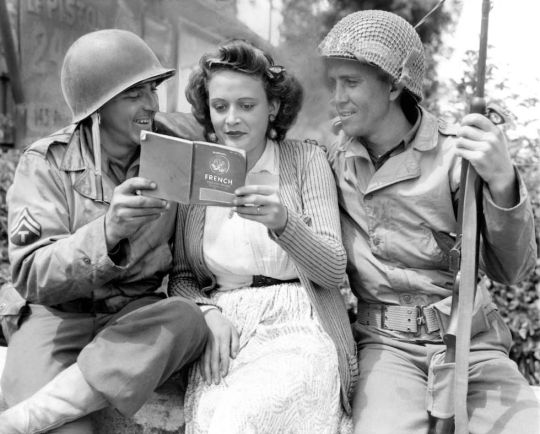
There was a lot of ground-level tension. Stars and Stripes (the U.S. military newspaper) covered the liberation of France with photos of American troops embracing and kissing French women, encouraging some of this tension.
Occasionally there was a photo of a GI giving candy to kids, but mostly coverage is about France as this land of romance and opportunity. There is evidence that some of the GIs took them at their word and after the liberation of Paris, they called Paris ‘the Silver Foxhole’ because it was the glittering place full of entertainment, but also brothels, legal and illegal, and other opportunities to meet French women.
There was also an internal power struggle between the external forces of de Gaulle and the Free French and the internal resistance, which was dominated by the French Communist Party.
There was a struggle for power over who was going to control the post-war situation. So there was liberation from the Germans, but in the power vacuum, there was also quite a bit of violence and political tension.
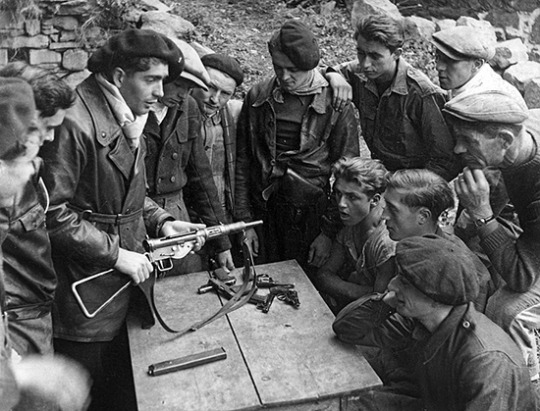
Of all the political groups in France who could really claim to have fought fascism from day one, the only group that could do that unambiguously were the Communists, going back to the 1930s.
Through the war the Communists were the largest and the most effective resistance force, particularly in the unoccupied zone. Part of that is that they were used to being organised in cells and operating clandestinely. Organisationally, they were in a good place to flip very quickly into resistance activity.
So it’s no wonder when the war was over the Communists had plenty of credit in the bank to draw from in seizing power and shaping France. One way they did it was to play up their resistance credentials (and putting under the rug any unsavoury parts). There was a short period of time at the end of the war and shortly afterward when people, especially in Central Europe, thought that communism was a viable alternative to the fascism under which they had been living with the Nazis and to the unstable governments that failed to stop the Nazis from rising to power. The French political Left benefited hugely from that in the post-war years.
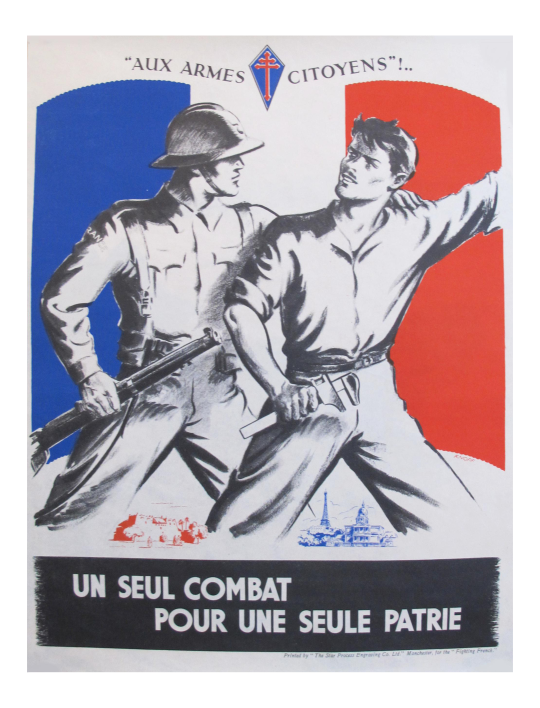
For other nationalists and other conservative French people the legacy of German occupation of France and its liberation was decidedly mixed because they themselves were divided in how they responded to the German occupation.
For a conservative patriot and nationalist like Charles de Gaulle, who more than the Communists embodied French resistance, he found the memory of D-Day so painful that he refused to participate in commemorations of the Normandy invasion during his eleven years as president of France. He did not invite heads of government to mark either the 20th anniversary in 1964 or the 25th in 1969. Old French and Allied soldiers saluted; ambassadors laid wreaths but President de Gaulle stayed away.
President Dwight Eisenhower had tried to salve the French hurt in the statement he released for the 10th anniversary in 1954. The statement did not mention the United States or its armed forces. It praised by name three British commanders, three French, one Soviet - no Americans. It credited the victory to “the joint labours of cooperating nations,” and said “it depended for its success upon the skill, determination and self-sacrifice of men from several lands.” You might want to read it as a prophylactic antidote to the boast and bombast likely to fill the air today.
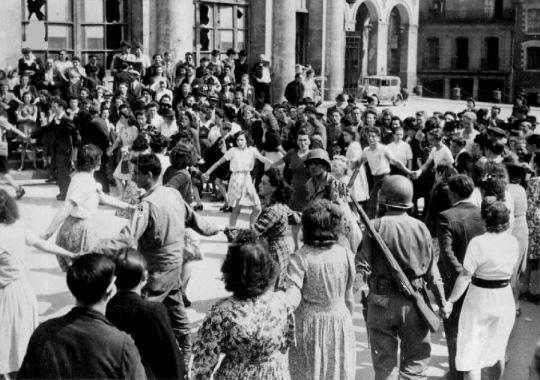
The experience of liberation was a complex thing for almost every country that experienced it from 1943 to 1945, but perhaps nowhere more so than in France. In the American and British imagination of 1944, France exists as a throng of cheering, welcoming faces, as women kissing Tommies and GIs, as a landscape through which Allied tanks and trucks roar on their way to Germany.
Depending on our mood, we romanticise the Resistance or excoriate collaborators - seldom caring to remember how ambiguously collaboration and resistance often blended together, or how often collaborators and resisters were the same people at different phases of the war or even different times of the same day.
To be liberated, first you must be defeated.
Everything about these D-Day anniversaries did remind the French of that humiliating sequence. When de Gaulle landed in Normandy for a one-day visit on 14 June 1944, he traveled back-and-forth across the English Channel in a British warship. De Gaulle’s ability to establish a provisional government depended on the permission of U.S. and British authorities - and so, ultimately, would the even more fraught question whether France would be accepted again as a major ally.

And then there were the other set of nationalists and conservative patriots who ultimately damned themselves: the Vichy regime of Marshal Pétain.
For four years, Vichy France had supplied and aided Germany. Vichy planes had bombed Gibraltar in 1940; Vichy tax collectors had extracted resources to pay the German occupiers. When Italy changed sides in 1943, it was treated as a liberated nation—but it was not accepted as a co-belligerent. France’s post-D-Day status utterly depended on British and American goodwill. For a man like de Gaulle, that dependency rankled.
De Gaulle’s famous speech of 25 August 1944, after the liberation of Paris, starkly reveals the fictions that would restore French pride.
“Paris! Paris outraged! Paris broken! Paris martyred! But Paris liberated! Liberated by itself, liberated by its people with the help of the French armies, with the support and the help of all France, of the France that fights, of the only France, of the real France, of the eternal France! … It will not even be enough that we have, with the help of our dear and admirable Allies, chased him from our home for us to consider ourselves satisfied after what has happened. We want to enter his territory as is fitting, as victors.”

France did enter Germany as a victor. French armies, supplied by the United States, subordinate to U.S. command, were stood up in 1944–45. France was allotted an occupation zone in Germany and awarded a permanent seat on the UN Security Council. (Italy was not even invited to join the United Nations until 1955.) Allied officialdom agreed to believe de Gaulle’s story that the France that fought Nazi Germany was the only ‘real France’.
But everyone understood the story was not true. The French military defeat in 1940 had torn apart social wounds dating back decades and longer.
Conservative and Catholic France reinterpreted the battles of 1940 as a debacle only of the liberal and secular France that had held the upper hand since the founding of the Third Republic in 1871 and especially since the Dreyfus affair that began in 1894. When the reactionary French writer Charles Maurras was sentenced to life imprisonment for collaboration, he supposedly replied, “It’s the revenge of Dreyfus.”
Most French business leaders and civil servants collaborated out of opportunism or necessity. The Germans held hundreds of thousands of captured French soldiers as hostages for years after 1940. But more than a few leading French people, including many right wing intellectuals and reactionary churchmen, collaborated out of a species of conviction.
The loss of the war against Germany enabled such people to launch a much more congenial culture war at home, to purge France of “liberty, equality, and fraternity,” the slogan of 1789, and establish in its place “work, family, fatherland,” the slogan of Vichy. Since 1905, France had been defined as a secular state.

Vichy put an end to all that. The defeat of France by Germany was ideologically reinterpreted as a victory of “deep France” over a shallow liberal metropolitan veneer. Subjugation was reinterpreted by Vichy ideologues as redemption. Enmity was shifted from the occupying Germans to the liberal commercial “Anglo-Saxons.” Vichy propagandists produced cartoons in which Mickey Mouse, Donald Duck, and Popeye were depicted dropping bombs on France at the behest of Jewish masters.
Anti-Allied enmity was not difficult to stoke: Allied bombing before 1944 and Allied land forces after 1944 did more damage to French cities than the Germans had in the few weeks of combat in 1940. The port of Le Havre was bombed 132 times from 1940 to 1944. The final raids in September reduced the city centre to rubble, killing 5,000, maiming and rendering homeless tens of thousands more. The modernist cityscape that replaced the former 18th and 19th-century core remains an enduring monument to the price paid by the French people for their liberation.
Vichyite enthusiasm for anti-liberalism opened a strange fluidity in French politics during and after the war. The future leader of French socialism, François Mitterrand, began his political career on the far right of French politics and worked until 1943 as a civil servant in the Vichy government. But as a socialist president after 1981, Mitterrand would raise minimum wages, cut the workweek to 39 hours, nationalise some financial institutions, and end the death penalty. He would even do what de Gaulle could never stomach: celebrate the D-Day anniversary. It was Mitterrand who decided to invite Ronald Reagan to Normandy in 1984.

The legacy of Vichy remains a sore wound and no one really wants to touch it too much. Within families, unless they have a history of someone who was in the resistance, no one really talks about the war. Time has emotionally detached the French somewhat from past painful memories of occupation and what went on under occupation. I personally believe we in Britain - who milk the fact that we stood alone…and only because we had a stretch of water and the might of the German war machine - and those in the US - who were oceans apart - shouldn’t judge the French as we were never under occupation.

Being under occupation brings out the worst in people as much as it brings out the best in terms of heroic defiance and resistance. But also for many it just brings resigned acceptance of how things are and everyone just put their head down to just survive.
Having lived through the tremendous instability of the interwar period and having lived through the First World War, which was living memory to many adults in Europe, the calculus looks really, really different than it did from the United States.

In having the privilege to have met American veterans of the Second World War, I think it would be fair to say that D-Day is very much a major touchstone for the American identity. A non-professional army of factory workers and schoolteachers got into uniform, they went to a place they didn’t know about and they fought the ‘bad guys’, and, using their skills and their talents and their cleverness, they overcame a much more powerful, ‘demonic’ enemy with insolent bravura and sheer guts.
When Americans choose to remember this heroic history, they do so from the privilege of an easier geography. As time has separated Americans from the Second World War - for the French and even the British - there is a feeling that American memories have become more triumphalist and self-aggrandising the further we move away from the Greatest Generation (who were heroic, stoic, uncomplaining, and just sought to get on with their lives once they got back home).
To many outside observers the heroics of those brave soldiers landing in Normandy on that fateful day has been held hostage to the vicissitudes of whatever ongoing culture war is taking place between Americans. Only Americans use the word ‘Nazi’ and throw it around at other people like it was confetti. Anyone and everyone can be accused of being a Nazi these days. So often is that word thrown around that it’s lost all meaning of its true import. The best way to end a heated argument is to accuse one’s opponent of being a Nazi.

History is always held hostage to the present. Take the Donald Trump. I don’t like him and on my blog I made plenty of posts disparaging him but I don’t think I ever painted him as a Nazi or a fascist (another over used and interchangeable word). Many of the left became hysterical at his election to the presidency. The rise of Donald Trump sparked many analogies to the politics of the 1930s which was always a historically illiterate analogy as well as a very dumb one.
Unlike Europe, contemporary American mentalities are not formed by vivid personal memories of the mass bloody slaughter of 1914-18. Current Americans have experienced nothing like the Great Depression or the civil unrest that piled bodies in the streets of interwar Berlin and Paris. Present day Americans are not haunted by the possibility that domestic communists might seize power and property in a revolutionary spasm. It’s never going to be 1933 again.
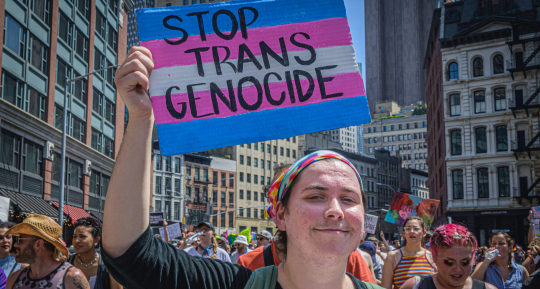
But what does remain from the past are the same human impulses for domination and control, the same way both fascists and communists thrived upon during a time of societal upheaval. Authoritarian impulses behind the curtailment of free speech, honest and critical discussions around gender ideology and indoctrination of school children, the illiberalism of many university campuses pushing diversity, inclusion, and equity indoctrination, all show they have been powerful forces for extremists to amplify in the unsettled present moment.

For the British, we tell ourselves a different story.
It is one of those intriguing coincidences of historical time that this week marked the anniversary of the evacuation of the British Expeditionary Force (BEF) from Dunkirk (June 4) and the anniversary of the D-Day landings (June 6).
Separated by four years and markedly different in terms of their ‘place’ in the Second World War – Dunkirk at the very ‘beginning’ and D-Day commencing the last act. But the two events have nonetheless become closely connected in our cultural memory – a connection that can be traced back to the war itself.
The evacuation of the British army from Dunkirk (and other French ports) in May-June 1940 was a military catastrophe of the highest order. This force had been despatched to France in the autumn as a demonstration of British support for their French ally, and for many of those in command it was seen as the successor to that valiant predecessor, the BEF of 1914.
Indeed, just like this predecessor, the army’s job was to support Belgian and French counterparts in the event of German attack, and many of its senior officers – all veterans of the First World War – likely anticipated a similarly lengthy residence across the channel. But it was not to be.
Aside from occasional moments of tactical success – notably the Battle of Arras – this 1940 ‘BEF’ eventually succumbed to the sheer speed of the German Blitzkrieg attack, which commenced in early May. Cut off in northern France and increasingly unable to affect the outcome of the Battle of France, a large-scale evacuation was commenced in late May. This evacuation - Operation Dynamo - would eventually return to Britain over 300,000 British, French, Belgian, Polish, and Czech troops.

For Winston Churchill, this was a “colossal military disaster” that he nonetheless quickly sought to convert into a “miracle of deliverance” demonstrative of British resilience and fortitude. The role of the now famous ‘little ships’ – the yachts, lifeboats, fishing trawlers and pleasure steamers – in bringing the troops back to Blighty received particular attention. Here was an example of ordinary Britons rallying to the cause while demonstrating their characteristic mastery of sail and sea. Meanwhile, Churchill readied the nation to “fight on the beaches” and to “never surrender”.
Fighting on the beaches would remain a preoccupation of Churchill’s for the remainder of the war. Indeed, soon after the British army was brought home from the beaches of France, Churchill was already pondering ways for it to return, and by 1941 he had appointed Commodore Lord Louis Mountbatten – his Chief Advisor for Combined Operations (that is, for amphibious assaults, long a favoured interest of the prime minister). This was the origins of the organisation which in due course would develop into General Dwight D. Eisenhower’s ‘Overlord’ command – the organisation which planned and commanded the Allied Invasion of Normandy in June 1944. In this sense, the very idea of ‘D-Day’ might be said to have been born on the beaches of Dunkirk.

This connection between the 1940 evacuation and the 1944 invasion similarly shaped how the British media framed the D-Day assault. British Movietone News for instance reported the landings in Normandy as “the story of how four years after Dunkirk…Britain came back” whilst The Times declared that “four years ago…the tide of war had flooded from the east into the French channel ports”, but now “the tide has turned”.
Once the war was won, such a connection between the ‘retreat’ and the ‘return’ only consolidated itself further. Various post-war histories of D-Day often opened with a chapter on Dunkirk, whilst the first feature film to focus on the Allied landings (D-Day: Sixth of June, 1956) likewise organised its narrative around this dualism, connecting via certain characters the despair of Dunkirk with the triumph of Normandy.
Ever since, this has remained a powerful dynamic shaping British memory of the war, with D-Day frequently defined by press and politicians - especially in the 1950s and 1960s - as the redemption of Dunkirk. Put differently, in our popular memory, D-Day performs a vital function for it asserts that what happened at Dunkirk was not, ultimately, a ‘defeat’ but instead a setback on the road to victory.

Separated by four years, and profoundly different in how they were lived and experienced, the connection in time and also in our memory between Dunkirk and D-Day hints at a persistent binary in our relationship with those across the channel. Put another way, our history is marked by various ‘retreats’ from Europe only to be followed later by a ‘return’. For me at least, this is the meaning - and hope - I shall choose to see this week as I reflect upon the anniversaries of 1940 and of 1944.
There is nothing wrong in telling the story that way, but it compresses a lot of complexity. What I think is regrettable is that we miss the rest of the year. Because from June of 1944 to May of 1945 is a very long, hard year, and that is when most of the casualties in Europe will be lost.
Getting back to the French I would say that when the French step back and think about the bigger picture from the actual events on D day in June 1944, it becomes ambiguous very quickly, because their Allied British and American liberators also brought destruction but freedom brought conflict and reprisal amongst themselves. Everywhere there were difficult moral and political questions about collaboration and behaviour during the occupation that were brought to the surface once the Germans were gone. It is a much more complex kind of story.
But you find it is much more complex when you dig into the British and American side as well. The mythologies never capture actual things that well. We hold hostage the genuine herosim of those brave soldiers landing on the bloody beaches of Normandy and those courageous ordinary French people resisting the Germans to the present. That’s why there is one thing that every historian says (or should say) at least six times a day: “Well, it was more complicated than that.” That applies equally well here.

Thanks for your question.
#question#ask#D Day#Normany#second world war#france#french#charles de gaulle#britian#america#history#war#legacy#french resistance#past#present#past vs present#remembrance#society#culture
49 notes
·
View notes
Text
I was bored so here yall have it: Les Mis if they played in a Minecraft SMP.
Courfeyrac: the second most trigger-happy player in the server. Only in half netherite though, he claims to have used all his netherite for his tools but is sported with an iron axe and a stone shovel on multiple occasions. His ign is _Courf.
Grantaire: potion boy, but is a nuisance about it. He stole all the netherwart from the nearest 10 nether fortresses (it made everyone give up finding netherwart themselves) and used his potions to troll people. He also sells them either for dirt-cheap or ridiculously expensive prices. His ign is GrandR.
Combeferre: Has the ign "FerreMan". Has a huge amassing army of villagers. Built a HUGE STRUCTURE containing EVERY SINGLE LIBRARIAN AND THEIR BOOKS IN EXISTENCE, with a toggleable raid farm in the centre (so as to grind for emeralds and totems, and getting hero of the village for the villager trades). Joly helped.
Joly: His ign is "doctorjoly", set by Bossuet. Freakishly good with redstone. Says that since he's studying medicinal science, he's attracted to anything remotely like science. Bossuet called out his bullshit, but it's probably true. Once caught him watching a 5-hour essay on redstone over his textbooks. Musichetta killed him that day.
Bossuet: Has the ign "BossGirlie". He just does whatever the hell he wants. Good on him, honestly.
Feuilly: The server's go-to for most, if not all things decoration. He took a special interest in banners and armour (he was DELIGHTED at the armour trim update), and is a texture/resource pack encyclopedia. He interior-designed almost every single house, building and structure in the SMP, and the others pay him handsomely for his services. Has the ign Feuilly, kindly given to him by someone online.
Bahorel: Has an ongoing war with Courfeyrac. The most trigger-happy player in the server. Unlike Courfeyrac, he has the gear. The two of them has killed each other more times than anyone has died in the server. If he's not fighting it out with Courf, he's grinding for more riches, trying to catch up to Jehan. His ign is "BawHorel".
Jehan: Strangely the richest and most geared player in the server. At first, he was suspected to having cheated in his gear, but seeing as he did not have administrator powers at all, he was proven innocent. (Grantaire, on one of his Spying™ moments, once witnessed Jehan continuously mining for 6 hours. He subsequently summoned the entire Amis IRL to pull him away from his computer and take him out for dinner.) Has the ign "Poet". How did he get it? Nobody will ever know.
Enjolras: He has a Minecraft account but dOeSnT wAnT tO wAsTe hiS TiMe pLaYiNg, saying that he has better things to do. Musichetta reported that Enjolras sometimes lurked in invis/spectator mode, when many of the players were online. His ign is "MrEnjolras".
Musichetta: Server admin. That's all that needs to be said... Ign "Chetta__".
Gavroche: Other than having the ign "Gavroche" and a Minecon Cape (Jesus Christ, Gav, how did you get this account? Cosette's dad, he'd say), he doesn't get on often since he's most of the time playing on Hypixel, but when he does, everyone simultaneously screams in chat.
Éponine: She's similar to Gavroche, only she is a leading figure in the anti-p2w community-
Her ign is "_epo9".
Cosette: Has the ign "CosetteF". Gets on when Marius gets on, just like how Marius gets on when Cosette gets on. There is a collective agreement to give Cosette as much as possible whenever she comes online.
Marius: Has the ign "MariusP", matching with Cosette. Gets on when Cosette gets on, just like how Cosette gets on when Marius gets on. There is a collective agreement to kill and bully him as much as possible, until Cosette tells them to stop.
(Bonus): Jean Valjean: Has two separate accounts, "Madeleine" and "Valjean" (both of them probably cost tens of thousands of dollars, he would swear to you that he got the igns when he created his two accounts). He has joined the server on three occasions: the first time on his Madeleine account (he was immediately banned by Musichetta and subsequently unbanned when people said that it was Cosette's dad), he joined back and hung around in the server directly after, and joined on his Valjean account the third time, and he was banned again. (He gave up after this.) (A note: he was whitelisted on both accounts, but was still banned on both occasions of joining with his accounts.)
(Bonus) Javert: Has the ign "Jav3rt", cuz some bastard took the name "Javert" before him. Got 200 stars in hypixel bedwars within one and a half years of playing (for reference, it took me 2+ years to get to 150). Is some sort of local micro-celebrity, due to his rank in the police force and the Amis leaking his ign on Twitter. On the SMP, he 1v2ed Bahorel and Courfeyrac and won due to the strategic use of potions and raw skills. You probably should not mess around with Javert.
#alphabet boys#les mis#les miserables#minecraft#les amis de l'abc#jean valjean#javert#inspector javert#enjolras#grantaire#courfeyrac#combeferre#jehan#joly#bossuet#bahorel#feuilly#musichetta#eponine#eponine thenardier#gavroche#marius pontmercy#cosette#cosette fauchelevent
43 notes
·
View notes